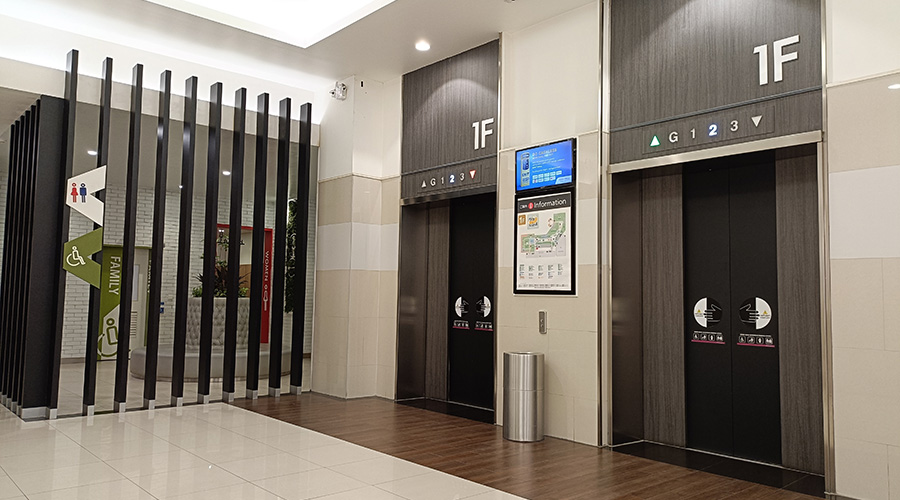Fire Escape?
A growing emphasis on full-building evacuation could end a ban on using elevators during a fire
By Brandon Lorenz, Senior Editor
For more than 30 years, the elevator industry’s message has been crystal clear: Do not use an elevator during a fire.
That message was formalized in 1973 after a series of fatal fires in New York during the late 1960s and early 1970s prompted change. Prior to that, occupants tried to exit a building during a fire using elevators, stairs or any other available means of egress.
“Some people in the industry say it has been the most successful message the industry has ever put out,” says Edward Donoghue, administrator for the National Elevator Industry Inc. and a safety and codes consultant.
Today, the elevator industry is taking a hard look at whether to change that message. The terrorist attacks of Sept. 11, 2001 have opened debate regarding whether elevators should be used during a fire. The debate is being fueled by the facts surrounding the evacuation of the World Trade Center.
A report released in April by the National Institute of Standards and Technology (NIST) indicated that nearly 3,000 occupants were able to evacuate WTC 2 because they used elevators in the 16 minutes before the second tower was struck. Overall, the rate of evacuation in WTC 2 was 108 survivors per minute, about 50 percent faster than WTC 1, at 73 survivors per minute, according to the report.
In the past, the assumption has been that the entire building wouldn’t need to be evacuated all at once, says Ron Cote, principal and life safety engineer for the National Fire Protection Association (NFPA). “That is being looked at after 9-11,” says Cote. “Obviously, elevators are a good tool for evacuation if you have to evacuate the whole building.”
Using elevators to evacuate during a fire is also being given consideration because elevators could be a practical way to evacuate occupants with disabilities, if elevators could be used safely.
For people with physical disabilities, having a rapid and safe means of egress in an emergency is extremely important, says fire and smoke consultant John Klote.
The ADA has long required emergency evacuation plans to accommodate the needs of people with disabilities. A Montgomery County, Md., judge reaffirmed that requirement in a December 2004 ruling. The judge ruled that a store in a mall was required to consider the needs of people with disabilities in developing emergency evacuation plans. The ruling came after a woman with disabilities was left behind when the mall she was in was evacuated after a fire alarm went off.
Current Elevator Fire Operation
Elevator use is governed by the American Society of Mechanical Engineers (ASME) A17 life safety code for elevators and escalators, though ASME requirements have to be adopted at the local level. Under ASME standards, once a fire has been detected, elevators operate under either Phase I or Phase II regulations.
Under Phase I operation, elevators that are 25 feet or more above the main floor return either to a designated landing area or an alternate area. Phase I operation is activated either manually by a special key, or automatically by a fire alarm initiating device. A sensor could detect smoke in the hoistway or machine room, for example, and trigger Phase I. The goal is to remove the elevators from service so that building occupants do not use elevators during a fire and become trapped.
Phase II operation is an override meant for firefighters after Phase I has been activated. Under Phase II operation, firefighters can use a keyswitch to operate the elevator, provided the hoistway is clear of smoke and the elevator has electricity.
Charting the Change
A March 2004 elevator industry workshop in Atlanta examined the question of using elevators for fire evacuation. The workshop also looked at elevator use by firefighters. Co-sponsors of the session were ASME, NIST, International Code Council, NFPA, International Association of Fire Fighters and the U.S. Access Board, which promulgates ADA guidelines.
The industry would face a series of technological and human challenges if it decided to approve emergency elevator use in a fire. Widespread use of elevators designed to evacuate occupants during a fire means that elevators would require more features. “How do you prevent overloading? How do you tell people what an elevator can and cannot do? How do you keep the elevator hoistways and lobbies clear of the fire?” says Donoghue. “There are many issues that are on the table that have to be addressed and none of them have been mitigated to the point where we can say we are ready to go forward.”
Another big issue is how long elevators would have to operate during a fire.
“The longer in the fire emergency you expect them to run, the more bells and whistles and protective features we have to add,” says Cote. An elevator that could safely evacuate tenants during a fire would need to be protected from fire, heat, smoke, water, power loss and overheating of the elevator equipment, says Klote. Elevators in earthquake-prone areas would also need extra protection.
ASME is conducting a hazard analysis to determine how elevators might be safely used for fire evacuations. No code changes are envisioned until the analysis is finished.
“We are looking at it more as, ‘Is it safe?’” says Donoghue. “It’s pretty easy to see how it would work. It’s feasible. The question is: Is it safe?”
A possible first step involves using elevators to give people with disabilities the option to evacuate during the very early stages of a fire, says Larry Perry, codes consultant for BOMA International.
Elevators can technically still operate during the very early stages of a fire — they are not called out of service until a fire alarm initiating device senses fire or smoke or an operator triggers Phase I activation manually. Elevators could therefore potentially be used to evacuate people with disabilities before Phase I activates, says Perry. Such an opportunity can be especially important in a high-rise building.
Employers and facility executives could not force people with disabilities to evacuate via an elevator during a fire. But they could offer the option, Perry suggests. “It’s up to that person to make the choice,” he says.
Human Challenges
Emergency elevator evacuation systems are not impossible — a handful of buildings are already equipped for such a use. A metro station in Montgomery County, Md., has elevators equipped for emergency evacuation because it is so far underground, Klote says. The Stratosphere Tower Hotel and Casino in Las Vegas also has elevators equipped for emergency evacuation because the hotel rooms are situated at the top of a narrow 1,149-foot-tall tower.
Despite those examples, the industry would face some challenges if a decision was made to use elevators for emergency egress. One challenge is the consistent message the elevator industry has been delivering since 1973 — don’t use elevators during a fire. Using elevators for emergency evacuation during a fire would require a more nuanced message. Elevators in newer buildings would potentially be more fire-resistant than those in older buildings, creating the risk of confusion for the public.
“From the educational side, I think building owners would have a bit of a task,” says Perry. “They’ve spent the last 30 years educating people that, when the fire alarm goes off, take the stairs. Now they’d be saying, ‘Well in some circumstances when the alarm goes off, you can use the elevator.’”
Another question that needs to be tackled: Which building occupants should use an elevator during a fire? There is a possibility that elevators could be reserved for people with disabilities or the elderly while other occupants would use the stairs.
“Maybe the message that has to get out is that elevators should be reserved for people who need them,” says Cote. “Otherwise, don’t be lazy, take the stairs.”
Measures would also have to be taken to prevent occupants from flooding the elevator lobby. “There will be many situations where you are going to find a lot of people will want to use the elevator,” says Perry. “You don’t want people on all 30 floors running to the lobby and pushing the down button.”
Technology that can keep water being used to fight the fire out of the elevator hoistways is also important. It is an area that needs additional research, Klote says.
What’s more, occupants would need an information system that directs them to the stairs if the elevators were either out of service or if the elevator was bypassing their floor.
One possible solution would be a traffic-light display position near an elevator cab, Perry says. Red would indicate the elevator is out of service and stairs should be used; yellow would indicate the elevator is in evacuation mode; green would signal normal elevator operation.
“If I am expected to wait for an elevator on the 40th floor of a building, I would want to know if that elevator is still in service,” says Cote. “I want to know in real time.”
A Measured Change
How likely is it that elevators will become a new escape route in a fire? It’s too early to know, says Donoghue. The first step is to complete the ASME hazard analysis. “What the industry and the NEII are saying is, ‘Let’s research it and then decide where we go from there.’ It is going to take some time. It’s not a simple process, but it provides an assurance of safety for the people using the elevator.”
If the hazard analysis shows that elevators can be safely used in a fire, many questions would still remain to be addressed before new requirements went into effect. It is still undetermined, for example, how fire-ready emergency evacuation systems on elevators might be phased into the market. Cote sees the requirement applying initially to new buildings only, with existing buildings being addressed further down the road.
Also undecided is how long it might be until elevator emergency evacuation systems might be required. The requirements can’t move any faster than technology developed by elevator manufacturers, says Cote. “They are participating in the process,” he says. “I think they will be quick in developing the necessary products once we know how to do it safely.”
Perry says he thinks that, if new requirements were to be approved, it would take five years before those requirements trickled down to many state and local code bodies.
Completing the ASME hazard analysis upfront will take more time, but the effort will reduce problems later in the process, Cote says. “You do all the work upfront, but the feasibility all shakes out from that hazard analysis. With every meeting it is moving and we are seeing progress.”
The complex nature of elevator emergency evacuation systems, combined with the importance of maintaining safety for building occupants, means that a decision on the future of elevator emergency evacuation systems will not be made soon. Given the magnitude of the change, Perry sees no need to rush the process.
“I would rather see things be up in the air and take several years, rather than throw things into the code and build some buildings to see if they work,” says Perry.
Report Suggests New Life Safety Systems for Tall Buildings
The National Institute of Standards and Technology has spent more than $20 million investigating the collapse of the World Trade Center. A goal of the investigation, started in August 2002, is to determine which building and fire codes, standards and practices warrant revision.
NIST released its draft summary report last month. The report includes the group’s principal findings, and 30 recommendations grouped into eight categories. Collectively, the 43-report project includes a summary, eight project reports and 34 supporting reports, totaling about 10,000 pages.
Among the recommendations:
- Fire-protected and structurally hardened elevators should be installed to improve emergency response activities in tall buildings by providing timely emergency access to responders and allowing evacuation of building occupants with impaired mobility. Such elevators should be installed for exclusive use by emergency responders during emergencies. In tall buildings, consideration also should be given to installing such elevators for use by all occupants.
- Tall buildings should be designed to accommodate timely full-building evacuation of occupants in case of building-specific or large-scale emergencies, such as widespread power outages, major earthquakes, tornadoes, hurricanes without sufficient advanced warning, fires, accidental explosions and terrorist attacks. Building size, population, function and iconic status should be taken into account in designing the egress system. Stairwell and exit capacity should be adequate to accommodate emergency responders entering a building.
- Egress systems should be designed to maintain their functional integrity and survivability under foreseeable building-specific or large-scale emergencies
- The full range of current and next generation evacuation technologies should be evaluated for future use, including protected/hardened elevators, exterior escape devices, and stairwell navigation devices, which may allow all occupants an equal opportunity for evacuation and facilitate emergency response access.
NIST is not a regulatory agency and its recommendations do not have the force of law. But the agency is working with the American Society of Mechanical Engineers’ (ASME) task force that is examining elevator use for emergency egress during a fire.
While ASME is still studying the issue, some developers are planning buildings with new life safety systems. An architect designing the Freedom Tower being built on the site of the former World Trade Center towers, announced in June the building would include pressurized stairs, low-level emergency lighting, and concrete protection for all sprinklers and emergency risers. The building’s elevators and sprinklers would be located in a central core of concrete that would be about 3 feet thick.
—Brandon Lorenz, senior editor
|
Related Topics:











